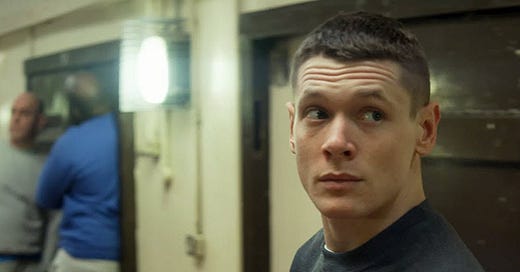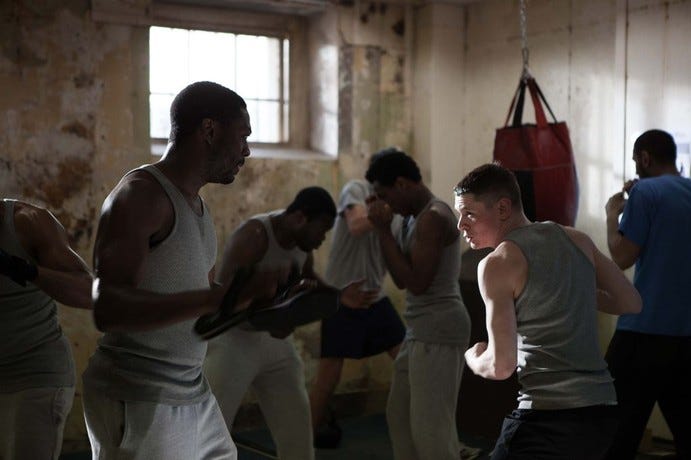My first thought upon hearing Jack O’Connell starred in this hardcore prison film was, eh, I dunno. A skinny, frail, pretty kid like that wouldn’t stand a chance – he’d mouth off at the wrong guy and immediately be taught a lesson. I knew a guy with his appearance and physicality who disappeared after a fight – when he reappeared in the SHU, his head had been swelled up like a Peanuts character, discolored and misshapen. But hey, three cheers for “acting” – O’Connell is pretty convincing as a runty little fight machine who can’t easily be put down.
This film has a pretty basic structure – O’Connell is young enough to be hiked up from juvie due to violent circumstances. This movie earnestly tries to address the racial divides within prison, with O’Connell spending the bulk of his time with Black inmates, but also earning sideways glances from all directions. Race fraternization is not common in prison – many of the “cars”/cliques are designed to operate along racial lines, and when you see a white guy infiltrate those circles, it’s often due to very special extenuating circumstances.
Anyway, this is a movie with a number of such contrivances – many of which I buy, but still – including the fact that O’Connell is being protected by a much older man. Ben Mendelsohn, the type of character actor that fits everywhere, is here as a testy high roller who, as we learn early on, is actually O’Connell’s dad. This dynamic is explosive for several reasons. Mendelsohn sees that his son is impulsive and prone to violence, so he wants to keep the peace in the prison. But he also wants to protect his son from harm. However, he’s also making a belated effort to finally be a father to this young hellraiser. And prison is probably the last place you’ll be able to genuinely teach discipline to someone. How do you teach maturity to someone in an environment that rewards childish transgression? Mendelsohn didn’t rise up the prison hierarchy by behaving.
O’Connell finds another father figure in Rupert Friend. I used to think Friend was also kind of a softie, even after playing the lead in “Hitman: Agent 47” (which, in fairness, was on TV all the time while I was in prison, and I never bothered to sample it). But he’s fashioned himself into a versatile character guy, and here he’s plenty convincing as a prison therapist. He’s a volunteer, which means he has no fear about being here, and he stands up to every threat skillfully, showing respect while also attempting to squash any beef. You have to thread the needle in prison if you’re not looking to fight everyone — show that you’re not going to back down, but know how to deflate tension without letting another man show dominance. Friend’s character seems to know how to do this, but you keep thinking he’s five minutes from taking a shiv.
Friend’s character is actually the basis of the real-life story – Jonathan Asser was a volunteer therapist at a rough British prison before he wrote this screenplay. Kudos to not making him the hero of this particular story, in any sense. What is true is the opposition Friend’s character faces from the administration. There’s no doubt within this narrative that the prison officials are scumbags, stuck between keeping the peace and getting in their feelings about perceived slights from the inmates. But Friend often receives orders that seem contradictory from staff, and when his group sessions are out of hand, the officials only exacerbate problems and dismiss him like a literal fly in the ointment. This is all sharply directed by David MacKenzie… Fun trivia – on the night of the 2016 election, we were watching a bootleg of MacKenzie’s Best Picture nominee “Hell Or High Water”.
Prison volunteers deserve a lot more support. Not only because they sometimes write pretty great movies. But because they are dealing not only with hostile inmates, but also with an unreceptive, resentful staff. I was a part of a college credit course in one institution, a course on the chemistry of the brain, and the woman coming to see us once a week from a local university was a real saint, a kind older lady with an open mind and a generous patience. Each time she came in, the staff frisked and searched her like she was a criminal – people in the visiting room were also familiar with this treatment. She took it in stride.
One day, she was quietly musing about a brain study she wanted to do, detailing how she wanted to do a presentation about how taste receptors work in the brain. It involved the consumption of chocolate, though she bemoaned that she couldn’t bring in food for the inmates under any circumstances. One of us spoke up and said we could buy chocolate bars off the commissary and do the experiment in class ourselves. She was amused by this, but also didn’t seem to expect anything given the reliability of the average inmate.
The very next class, an inmate approached her desk and placed several handfuls of the candy bars on her desk in order to try the experiment. Before she could react, an officer stepped in. He grabbed the bars and shut the class down immediately. The claim was that an inmate was sharing food with a volunteer. Again, like a criminal, she was escorted out, and the class was canceled that day. And also, forever – she immediately relinquished her responsibilities and left the program due to that incident. This is just one of many accounts you’ll probably read about the tensions between staff and volunteers. And, while I have no evidence of this, I’m about 100% sure that officer took those chocolate bars home to eat himself.







